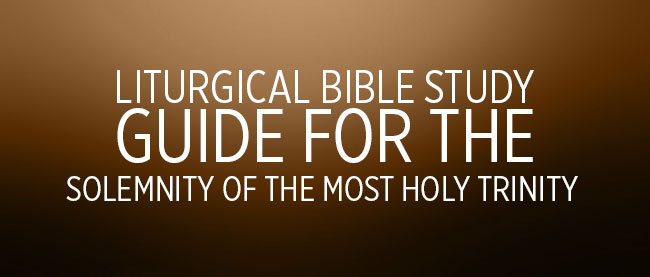Introduction
The doctrine of the Trinity describes the unique ways that we experience God’s presence in our lives. It is a confusing doctrine, even for adults, because it seems to imply three gods who are yet One God. When we speak of the mystery of creator and creation, we can only apprehend that mystery by analogy, poetry, and symbolic language. What we describe with the doctrine of the Trinity is an experience of God.
First, we know God through His creation and through our own creative acts. When we make something, whether it be a piece of furniture or a special meal, we are in touch with God as we shape something into a different form. The intense fulfillment of childbirth is another example of creative time. When we are creative, we feel whole and fulfilled. God is creating through us, and we have a sense of being an instrument for the Divine. We call this way of experiencing God “Father”.
Secondly, we know God in the sense expressed in 1 John 4:16 “God is love, and He who abides in love abides in God, and God abides in him.” God is as close to us as the healing love that is shared among His people. It was Jesus who proclaimed this reality by the power of love He showed in His life, death, and resurrection. Using the metaphors of biblical language, we could say that we “meet Christ” in the acts of love and healing. We know God through the “flesh and blood” of His presence in our lives and through the power of love that leads us into deeper life. We call this way of experiencing and knowing God “Son”, since Jesus is called the Son of God.
Finally, we feel the spirit and are “turned on” to God’s power. We know God through the inspiration that comes to us. Our secular use of the word “spirit” describes very well the experiences of God we feel through spiritedness and inspiration. When I say that certain words “came to me” in a moment of crisis, I feel I am describing the experience of receiving inspiration. As Christians we simply add the word “Holy” to the everyday word “Spirit” to define the spirited way of knowing God in our lives. Thus we can say that we know God as Father, Son, and Holy Spirit.
The dogma of the Trinity has not always been clearly defined. In fact, the word “trinity” does not appear in Holy Scripture (neither does the word “pope”, “purgatory”, or “catholic” for that matter – as our fundamentalist brothers and sisters will be quick to point out). It is not even clear how the doctrine was understood in the time of the apostles. The oldest doctrinal formulation of the Church’s belief in the Trinity is in the Apostle’s Creed, which, in the form of the ancient Roman baptismal symbol, served as the basis of catechumenical instruction and as a baptismal confession of faith since the second century.
In the early Church, Christians began to ponder the mystery of God’s unity and the Trinity and attempted to explain more precisely the relationships among the persons of the Trinity. These efforts led to many errors in the early years, and most of those who tried to describe the relationships ended in heresy. Even the great theologians Tertullian and Origin stumbled into error in their attempts to explain the relationship between the Father and the Son. Arius, around the year A.D. 300, concluded that the Word (logos) of God was created by the Father to be the instrument of all other creation. The Word, or God the Son, was a perfect creature to Arius, but a creature nonetheless. Were this account true, then only the Father would be truly God, and the Son and Holy Spirit would then be divine only through adoption by the Father. In such a case, the Most Holy and Undivided Trinity would become merely a descending hierarchy with the Father extending His grace to the Son and the Holy Spirit, rather than a communion of co-equal and co-eternal persons, who together are the one, true God. Arianism finally died out almost 500 years later at the end of the 7th century. Arianism has been revived by the Jehovah’s Witnesses who deny that Jesus is God.
The creed which we call the Nicene Creed originated at the Council of Nicea in A.D. 325. It was probably introduced into the western liturgy by the regional Council of Toledo in A.D. 589. That text however, was a Latin translation of the Greek original and came to include a small addition which resulted in major theological disputes: namely that the Holy Spirit “proceeds” from the Father and the Son, rather than only from the Father. This matter continues to divide Catholic and Protestant Christians from Eastern Orthodox Christians.
1st Reading – Exodus 34:4b-6, 8-9
Our first reading for today describes our Three-in-One God as “a merciful and gracious God, slow to anger and rich in kindness and fidelity,” who pardons our wickedness and sins and receives us as their own. This is what the Trinity does for us.
The events leading up to today’s first reading are as follows:
Moses has led the people out of Egypt and through the desert to Mount Sinai. This journey took about three months during which time they have encountered bad water which Moses, at God’s command, sweetened by casting a tree into it; they have run out of food and God has provided manna and quail; they have no water and Moses, at God’s command, strikes a rock with his staff and water flows forth.
Upon arriving at Mount Sinai they set up camp and Moses receives from God the words to speak to the Israelites: “Therefore, if you hearken to my voice and keep my covenant, you shall be my special possession, dearer to me than all other people, though all the earth is mine. You shall be to me a kingdom of priests, a holy nation. That is what you must tell the Israelites.” (Exodus 19:5-6). Moses told the people, through their elders, all that God had told him and the people replied “Everything the LORD has said, we will do.” (Exodus 19:8). Moses told this to God who further instructed Moses who then consecrated the people and they washed their clothes (purified them) and they were instructed to abstain from sexual relations for three days at which time God would come down upon the mountain and they will hear Him speaking to Moses.
Three days later, God comes down upon the mountain in thunder, lightning, and a thick cloud and the people are afraid to approach (the inference is that they have not abstained from sexual relations). God then gives Moses the ten commandments orally along with other instructions and then summons Moses alone to ascend the mountain. Moses ascends and remains on the mountain for forty days during which time he receives the ten commandments in stone.
Toward the end of his stay on the mountain, the people prevailed upon Aaron (Moses’ elder brother) to fashion the golden calf. God became angry and was set to destroy the people and raise from Moses a great nation but Moses reminded God of His covenant with Abraham and God relented. Moses then descended the mountain, caught the people in their revelry, and smashed the stone tablets. The Levites then ordained themselves by slaying three thousand of their kinsmen and neighbors (those who had been partaking in the revelry before the statue). God then commands Moses to make two new tablets and bring them up the mountain.
2nd Reading – 2 Corinthians 13:11-13
Our reading today comes from the final three verses of Saint Paul’s letter to the Corinthians. These final words form a greeting and an exhortation to the hearers.
Gospel – John 3:16-18
Our reading for today comes from the much larger story of Jesus’ encounter with Nicodemus. Nicodemus is mentioned only in John’s gospel (in chapter 3 and also in 7:50 and 19:39); however, the name was a common one. Although the Sanhedrin (the Jewish governing body that was recognized by the Romans), was composed mainly of Sadducees, it also contained Pharisees among its members (Acts 5:34). John 3:1 calls him a “ruler of the Jews” which probably means he was a member of the Sanhedrin. John 19:39 says he accompanied Joseph of Arimathea (also a member of the Sanhedrin according to Mark 15:43) to claim and bury Jesus’ body. As a Pharisee, a member of the Sanhedrin, and a rabbi (John 3:10 calls him a “teacher of Israel”), he represents the quintessential Jew. Jesus is addressing Nicodemus in our gospel reading for today as we hear Saint John give us the essence of the Trinity’s work for us: “God so loved the world that He gave His only Son, that whoever believes in Him may not die but may have eternal life. God sent the Son into the world that it might be saved through Him.” This is how much the Trinity loves us!


